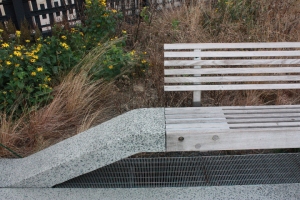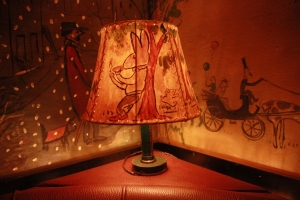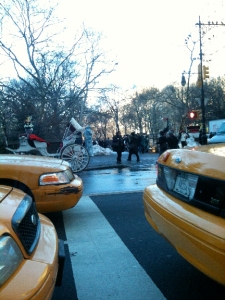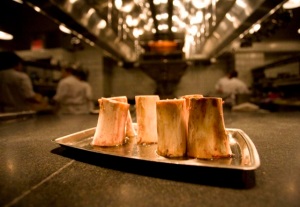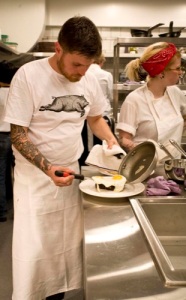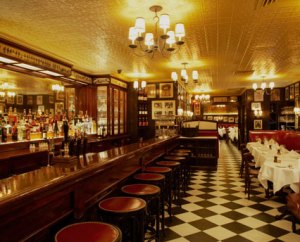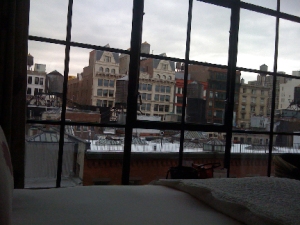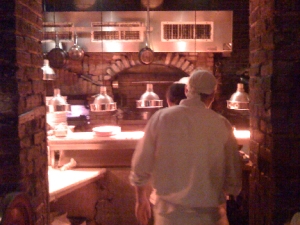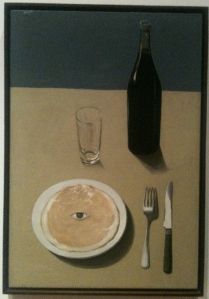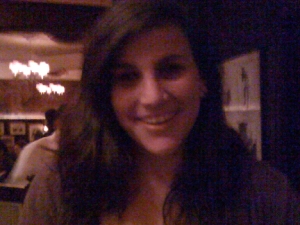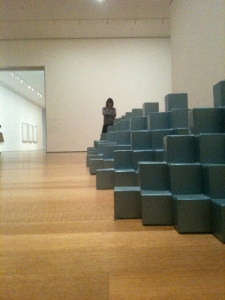(Originally posted December 8, 2010)

I often start to write these blogs in my head, which saves time when I can edit in there as well. Last week in NYC, walking blissfully through a Central Park ablaze with glorious fall color, I was playing with the idea of using Oz as a metaphor for the role the city has played in my life. At the exact instant I thought naw, yellow brick roads of possibility is going to sound trite, a tumultuous windstorm came out of nowhere, lifting thousands of leaves high into the air. Runners halted, mothers covered their children’s heads, tourists like Geoff and I, stunned, looked around dumbly, as if for the culprit. It was a truly serendipitous moment, magical, but also a bit unnerving. Classic New York.
I was in New York ostensibly to help my second son relocate from London. Secretly however, I also went in hopes a week there would shake me from the awful mood I had been unable to vanquish since the election. The tenor of discourse in the country has fallen so low, grown so ugly, I have begun to fear that nothing good will ever come from the way we currently practice democracy. Where are we going as a nation? Who are we anymore? As the world sinks into what feels like unprecedented violence, both natural and man-made, too many Americans have resorted to a mindset ever more petty and short sighted, deeply mistrustful of anything which requires intellect or reason.
In the past New York has afforded me solace, if not answers to questions like these. I was 16 when my despairing parents, “at our wits end!” shipped me off to a very rich aunt who lived on the Upper East Side of Manhattan. They were expecting a miracle, or, failing that, a short course finishing school. My aunt took one look at me in full hippie attire, a backpack of contraband and a guitar I could not play slung over my shoulder, threw up her hands and promptly decamped to her daughter's house in Connecticut. The closest thing I had to minders for the rest of the summer was a cabal of doormen who thought I was crazy. I wasn’t. I was confused and deeply disillusioned, mostly about the war in Vietnam.
Though I only lasted the summer, by happenstance several things conspired to keep me safe and propel me to a place where I began the long journey trying to make sense of Power with a capital P, and the creaky way it turns most people’s lives on history’s spit. I was young, dumb and stoned enough most of the time not to fear the city, and as I was intrepid in my appetite for adventure, explored Manhattan from Harlem to what was then a meatpacking district with actual butchers. Coming from monosyllabic LA, where vocabulary basically consisted of only three statements ~ “far out,” “that’s cool (especially when something wasn’t), and “bitchen” (when something was), I was fascinated with the way new yawkers talked, talked, talked. Everyone, from the countess across the hall to the taxi drivers who picked me up late at night, dispensed advice. In Paris success in social conversation resides in the perfect bon mot, in Italy the well chosen hand gesture, in New York it means 'having the last word.' Which of course is not a word at all, but a stream of passionate, opinionated, often colorful lectures that fall somewhere between a short story and a graduate thesis. On any subject. Even if marginally not worth talking about in the first place.
 On long hot muggy days, waiting for night to fall, I stalked the halls of great old American buildings stuffed with Robber Baron art, starting with the Frick, one of greatest small museums in the world, which happened to be right across the street. It was my first exposure to art where I wasn’t tagging along with my mother, or forced to look at muddy prints in boring school lessons. Experiencing it on my own, from a vulnerable yet curiously open place, it opened my eyes to a number of things. The first was that Americans didn’t understand sex or the female body, (I was from LA, remember, which still doesn’t). It was incredibly exciting to know there was a whole sensual world out there. The second, which spoke directly to the pain I was in, was the extent to which art was a valuable witness to the misuse of power that is repeated in every age, no matter who the man was behind the curtain is. What was taking place in my lifetime wasn’t an aberration of history. While I must have already known this on some level, instead of making me even sadder, as I studied canvas after canvas of masterful paintings and sculpture going back more than 500 years, I began to see a concurrent theme of hope and ambition. One that, against the odds, almost seemed to be fueled by adversity. The history of art is the history of an indomitable human spirit, a hunger not just to survive, but to see the beauty in life, bruised though it may be. Life is opportunity, which for an artist starts with the very impulse to pick up a brush or chisel.
On long hot muggy days, waiting for night to fall, I stalked the halls of great old American buildings stuffed with Robber Baron art, starting with the Frick, one of greatest small museums in the world, which happened to be right across the street. It was my first exposure to art where I wasn’t tagging along with my mother, or forced to look at muddy prints in boring school lessons. Experiencing it on my own, from a vulnerable yet curiously open place, it opened my eyes to a number of things. The first was that Americans didn’t understand sex or the female body, (I was from LA, remember, which still doesn’t). It was incredibly exciting to know there was a whole sensual world out there. The second, which spoke directly to the pain I was in, was the extent to which art was a valuable witness to the misuse of power that is repeated in every age, no matter who the man was behind the curtain is. What was taking place in my lifetime wasn’t an aberration of history. While I must have already known this on some level, instead of making me even sadder, as I studied canvas after canvas of masterful paintings and sculpture going back more than 500 years, I began to see a concurrent theme of hope and ambition. One that, against the odds, almost seemed to be fueled by adversity. The history of art is the history of an indomitable human spirit, a hunger not just to survive, but to see the beauty in life, bruised though it may be. Life is opportunity, which for an artist starts with the very impulse to pick up a brush or chisel.
We stayed at The Surry for the first three days, a hotel not far from my old haunting grounds. In the clear bracing sunshine we walked in the park, took our time over delicious prix fixe lunches at Café Boulud (which happily was attached to our hotel), then climbed the big steps of the Met and went our separate ways, or slowly trailed each other, until just before closing. Below are my notes on a few of the shows that I saw. The Barndiva Newsletter is primarily focused on food and art; both are sources of nourishment without which we cannot survive. But even if you are not traveling East in the next few months, the diversity of what you find in any great museum is essential viewing. The Met, sadly, is one of the few in NY that is still free if you do not have the money to donate ‘an appropriate’ entrance fee. It astounds me that we are making fine art an elitist sport in this country when it offers one of the few singular opportunities for citizens of all persuasions (income levels, ethnicities, religions) to come together in consideration of shared human values. Go to a museum and look around, not just at what is on the walls.
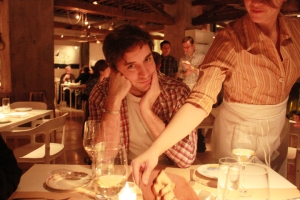 I won’t lie: while my time in NYC’s museums and parks topped up a flagging spirit, the most important moments for me on this trip were those I spent with my family. Seeing the Metropolitan Opera’s Così fan Tutte with my daughter ~ her first opera experience. Having a grown son know enough about New York (and for that matter, life) to guide us straight into Bemelmans Bar when the sky opened and a sudden rainstorm clamored down. Noisy and late dinners at Del Posto, abc kitchen, Pastis, where, for a few hours, it was permissible to believe that good restaurants, the ones that source with their hearts and take care to provide great service, like Barndiva, will survive this recession. (A glass raised to Mario Batali who has the biggest balls right now in this big balled restaurant town, not only for what it took to build the beautifully retro Del Posto and take it to four stars, but for his just launched and truly audacious attempt, with his partners, the mother and son Bastianich, to create America’s first great food hall in Eataly).
I won’t lie: while my time in NYC’s museums and parks topped up a flagging spirit, the most important moments for me on this trip were those I spent with my family. Seeing the Metropolitan Opera’s Così fan Tutte with my daughter ~ her first opera experience. Having a grown son know enough about New York (and for that matter, life) to guide us straight into Bemelmans Bar when the sky opened and a sudden rainstorm clamored down. Noisy and late dinners at Del Posto, abc kitchen, Pastis, where, for a few hours, it was permissible to believe that good restaurants, the ones that source with their hearts and take care to provide great service, like Barndiva, will survive this recession. (A glass raised to Mario Batali who has the biggest balls right now in this big balled restaurant town, not only for what it took to build the beautifully retro Del Posto and take it to four stars, but for his just launched and truly audacious attempt, with his partners, the mother and son Bastianich, to create America’s first great food hall in Eataly).
I also won’t lie that all those experiences cost money. A not inconsiderable amount of it. My point is that even as we feed the essential personal narratives in our lives, to whatever extent we find important and can afford, we need to make time to consider upping our participation in institutions and public open spaces that everyone can enjoy and reflect in.
On one of our last days Geoff and I walked the new High Line Park, on the lower east side, where we were now staying. Even in the cold, without the families with dogs and young children, it was easy to see what a wonderful addition this park is to the city. Designed by the always excellent Diller, Scofidio + Renfro out of a raised rail track built in the 1930’s but unused for the past thirty years, it instantly transforms one’s view of the city ~ not just the views down into the streets, but an inner view of what it means to reclaim and interact with awkward unused urban spaces. The High Line is a sculptural park with simple but sinuous benches of concrete and old wood that rise up out of the old tracks. The hardscape is softened with a landscaping plan by James Corner primarily of grasses which pay homage to what had been growing there wild, since the trains stopped running.
 I was greatly impressed with Man, Myth, and Sensual Pleasures: Jan Gossart's Renaissance, an exhibit of lush representational color with a politically subversive subtext which must have raised eyebrows at the time. The Dutch empire fell from a height of considerable power for sins of hubris, so make your own connections on that score. This was a good one for me to see right now.
I was greatly impressed with Man, Myth, and Sensual Pleasures: Jan Gossart's Renaissance, an exhibit of lush representational color with a politically subversive subtext which must have raised eyebrows at the time. The Dutch empire fell from a height of considerable power for sins of hubris, so make your own connections on that score. This was a good one for me to see right now.
 In conjunction with viewing the work of Gossart, I was really looking forward to an exhibit of a series of Joan Miró pieces that the great Spanish artist did shortly after he returned from studying the Dutch masters at the start of his career. But while the works in Miró: The Dutch Interiors makes clear the colorful and compositional connections between what would seem two remarkably incompatible styles, the show was not as revealing as I hoped. Not really a surprise: Miró is to the Dutch movement like Jeff Koons is to real sex. Having said that, for me, a day where you can see three roomfuls of Mirós, even marginal ones, is always a joy.
In conjunction with viewing the work of Gossart, I was really looking forward to an exhibit of a series of Joan Miró pieces that the great Spanish artist did shortly after he returned from studying the Dutch masters at the start of his career. But while the works in Miró: The Dutch Interiors makes clear the colorful and compositional connections between what would seem two remarkably incompatible styles, the show was not as revealing as I hoped. Not really a surprise: Miró is to the Dutch movement like Jeff Koons is to real sex. Having said that, for me, a day where you can see three roomfuls of Mirós, even marginal ones, is always a joy.
 Of the exhibits I managed to see, I was least impressed with John Baldessari: Pure Beauty, the much touted show of the season, which, intended irony aside, simply was not. (beautiful) For me this show was another case of the Emperor's New Clothes a la Art Basel. From all accounts Baldessari was a great teacher, but in even his strongest work here (and with the exception of what he burned in the 70’s, it's all here) this is art with a heart of stone, wordplay that is dated, video that makes me long for Nam June Paik. Baldessari is an LA artist in the same way Frank Gehry is an LA architect. There is great irreverence here to be admired, a “take that” attempt at disarming pretension anyone hoping to survive LA must have in their DNA, but whereas Gehry plays to his strengths in three dimensions, Baldessari’s antipathy to negative space produces work that is flat and ugly, devoid of even a rueful use of color. I would love someone to explain why this shit works for them.
Of the exhibits I managed to see, I was least impressed with John Baldessari: Pure Beauty, the much touted show of the season, which, intended irony aside, simply was not. (beautiful) For me this show was another case of the Emperor's New Clothes a la Art Basel. From all accounts Baldessari was a great teacher, but in even his strongest work here (and with the exception of what he burned in the 70’s, it's all here) this is art with a heart of stone, wordplay that is dated, video that makes me long for Nam June Paik. Baldessari is an LA artist in the same way Frank Gehry is an LA architect. There is great irreverence here to be admired, a “take that” attempt at disarming pretension anyone hoping to survive LA must have in their DNA, but whereas Gehry plays to his strengths in three dimensions, Baldessari’s antipathy to negative space produces work that is flat and ugly, devoid of even a rueful use of color. I would love someone to explain why this shit works for them.
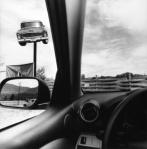 Which is not to say that living the vida loca (modern life IS crazy) does not come with a concomitant desire to take a deeper look at why post war prosperity ultimately led to the American soul becoming disenfranchised. American’s suffer from a misconception of what material wealth really brings to the table, that much is clear and sorely needs to be addressed. Lee Friedlander: America By Car at the Whitney (which I wandered into by accident on my way to visit the Hopper exhibit upstairs) is the real deal. Taken over the last decade through his car window while he crisscrossed America, it is one of those shows that builds as you move through it. The exhibit is a revelation that speaks to Friedlander’s talent for composition which brilliantly straddles wit with profundity. Image after image reveals what happens when our insatiable hunger for illusion gets left by the roadside. Like unfinished poems, the detritus and people he captures along the highways and byways of this country made the point about junk culture the Baldessari exhibit didn’t. Think Wim Wenders of Paris, Texas crossed with Bruegel the Elder if you transferred his work to black and white and then set to having some fun with a mimeo machine.
Which is not to say that living the vida loca (modern life IS crazy) does not come with a concomitant desire to take a deeper look at why post war prosperity ultimately led to the American soul becoming disenfranchised. American’s suffer from a misconception of what material wealth really brings to the table, that much is clear and sorely needs to be addressed. Lee Friedlander: America By Car at the Whitney (which I wandered into by accident on my way to visit the Hopper exhibit upstairs) is the real deal. Taken over the last decade through his car window while he crisscrossed America, it is one of those shows that builds as you move through it. The exhibit is a revelation that speaks to Friedlander’s talent for composition which brilliantly straddles wit with profundity. Image after image reveals what happens when our insatiable hunger for illusion gets left by the roadside. Like unfinished poems, the detritus and people he captures along the highways and byways of this country made the point about junk culture the Baldessari exhibit didn’t. Think Wim Wenders of Paris, Texas crossed with Bruegel the Elder if you transferred his work to black and white and then set to having some fun with a mimeo machine.
 My favorite show this fall, perhaps because I was on a lover's journey in New York, was Stieglitz, Steichen, Strand which takes up a number of connecting backrooms at the Met. Stieglitz, the master teacher, and his two most famous protégées (who arguably overtook him in the craft) captured images from a mindset we hardly remember now as the instant documentary aspects of the medium have subsumed the painterly qualities they sought to capture. In addition to being beautiful in their own right, most of these images are fragrant love letters to New York, and while I have seen many of them before, seeing them collected together in room after room, made me realize that all the bells and whistles we've added to the medium of photography hasn't done as much to capture its soul as envisioned by these pioneers. Technical virtuosos in their day, while that aspect of their work is no longer remarkable to our 21st Century eyes, their approach to the details of everyday life is all the more thrilling when you realize so much of what they captured happened in the incredible city right outside the door of the museum.
My favorite show this fall, perhaps because I was on a lover's journey in New York, was Stieglitz, Steichen, Strand which takes up a number of connecting backrooms at the Met. Stieglitz, the master teacher, and his two most famous protégées (who arguably overtook him in the craft) captured images from a mindset we hardly remember now as the instant documentary aspects of the medium have subsumed the painterly qualities they sought to capture. In addition to being beautiful in their own right, most of these images are fragrant love letters to New York, and while I have seen many of them before, seeing them collected together in room after room, made me realize that all the bells and whistles we've added to the medium of photography hasn't done as much to capture its soul as envisioned by these pioneers. Technical virtuosos in their day, while that aspect of their work is no longer remarkable to our 21st Century eyes, their approach to the details of everyday life is all the more thrilling when you realize so much of what they captured happened in the incredible city right outside the door of the museum.
Links: The High Line The Surrey Hotel (I booked The Surrey at half price on Jetsetter which you can join for free.) My favorite travel site, Tablet, also has auctions every week worth checking out if you are willing to spend a bit more on boutique accommodations. SoHo House- These are among the biggest and most comfortable rooms in Manhattan if you can take the neighborhood which parties on Fridays and Saturdays until the wee hours. Great spa and you are graciously invited to all the in-house events. I came back from dinner too late one night for the premier of Paul Haggis' The Next Three Days but I crashed the after party and though I knew not a soul, had a good time.



